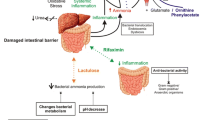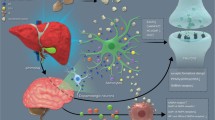Abstract
Minimal hepatic encephalopathy (MHE) is a neurocognitive disorder that affects up to 80% of cirrhotic patients. Similar to overt hepatic encephalopathy, ammonia and oxidative stress play key roles in the pathogenesis of MHE. However, MHE is characterized by subtle deficits and psychomotor abnormalities that can only be elicited by specialized psychometric tests. Although no gold standard exists for the diagnosis, MHE remains an important entity for clinicians to recognize because of its negative impact on a patient’s health-related quality of life and association with driving impairment and vehicle accidents. MHE has also been associated with an increased rate in the development of overt hepatic encephalopathy and increased mortality; therefore, identification and treatment should not be delayed. Treatment to date has been focused on reducing serum ammonia levels with agents such as lactulose, probiotics, and synbiotics. MHE is a real and growing problem that is epidemic in cirrhosis, and increasing awareness of this condition is necessary for adequate management of these patients.
Similar content being viewed by others
References
Papers of particular interest, published recently, have been highlighted as: • Of importance •• Of major importance
•• Bajaj JS, Wade JB, Sanyal AJ: Spectrum of neurocognitive impairment in cirrhosis: implications for the assessment of hepatic encephalopathy. Hepatology 2009, 50:2014–2021. This article provides a detailed analysis of the available testing strategies for MHE and the need to treat this as a spectrum of disease.
Ferenci P, Lockwood A, Mullen K, et al.: Hepatic encephalopathy—definition, nomenclature, diagnosis, and quantification: final report of the working party at the 11th World Congresses of Gastroenterology, Vienna, 1998. Hepatology 2002, 35:716–721.
Mullen KD: Review of the final report of the 1998 Working Party on definition, nomenclature and diagnosis of hepatic encephalopathy. Aliment Pharmacol Ther 2007, 25(Suppl 1):11–16.
• Randolph C, Hilsabeck R, Kato A, et al.: Neuropsychological assessment of hepatic encephalopathy: ISHEN practice guidelines. Liver Int 2009, 29:629–635. This review provides a consensus for neuropsychological assessment in patients at risk for MHE.
Dhiman RK, Saraswat VA, Sharma BK, et al.; Indian National Association for Study of the Liver: Minimal hepatic encephalopathy: consensus statement of a working party of the Indian National Association for Study of the Liver. J Gastroenterol Hepatol 2010, 25:1029–1041.
Sharma P: Minimal hepatic encephalopathy. J Assoc Physicians India 2009, 57: 760–763.
Dhiman RK, Chawla YK: Minimal hepatic encephalopathy. Indian J Gastroenterol 2009, 28:5–16.
Sharma P, Sharma BC: Predictors of minimal hepatic encephalopathy in patients with cirrhosis. Saudi J Gastroenterol 2010, 16:181–187.
Bajaj JS: Minimal hepatic encephalopathy matters in daily life. World J Gastroenterol 2008, 14:3609–3615.
Sharma P, Sharma BC, Puri V, Sarin SK: Natural history of minimal hepatic encephalopathy in patients with extrahepatic portal vein obstruction. Am J Gastroenterol 2009, 104:885–890.
Groeneweg M, Quero JC, De Bruijn I, et al.: Subclinical hepatic encephalopathy impairs daily functioning. Hepatology 1998, 28:45–49.
Groeneweg M, Moerland W, Quero JC, et al.: Screening of subclinical hepatic encephalopathy. J Hepatol 2000, 32:748–753.
Zhou YQ, Chen SY, Jiang LD, et al.: Development and evaluation of the quality of life instrument in chronic liver disease patients with minimal hepatic encephalopathy. J Gastroenterol Hepatol 2009, 24:408–415.
Kim Y, Park G, Lee M, Lee JH: Impairment of driving ability and neuropsychological function in patients with MHE disease. Cyberpsychol Behav 2009, 12:433–436.
Wein C, Koch H, Popp B, et al.: Minimal hepatic encephalopathy impairs fitness to drive. Hepatology 2004, 39:739–745.
Bajaj JS, Hafeezullah M, Zadvornova Y, et al.: The effect of fatigue on driving skills in patients with hepatic encephalopathy. Am J Gastroenterol 2009, 104:898–905.
•• Bajaj JS, Saeian K, Schubert CM, et al.: Minimal hepatic encephalopathy is associated with motor vehicle crashes: the reality beyond the driving test. Hepatology 2009, 50:1175–1183. This article provides actual translation from driving tests to retrospective and prospective driving offenses in MHE patients.
Kircheis G, Knoche A, Hilger N, et al.: Hepatic encephalopathy and fitness to drive. Gastroenterology 2009, 137:1706–1715.
Mullen KD: Pathogenesis, clinical manifestation, and diagnosis of hepatic encephalopathy. Semin Liver Dis 2007, 27:3–9.
•• Seyan AS, Hughes RD, Shawcross DL: Changing face of hepatic encephalopathy: role of inflammation and oxidative stress. World J Gastroenterol 2010, 16:3347–3357. This article provides a comprehensive review of the pathophysiologic mechanisms of ammonia and oxidative stress in the development of MHE.
Mullen KD, Ferenci P, Bass NM, et al.: An algorithm for the management of hepatic encephalopathy. Semin Liver Dis 2007, 27:32–48.
Gorg B, Qvartskhava N, Bidmon HJ, et al.: Oxidative stress markers in the brain of patients with cirrhosis and hepatic encephalopathy. Hepatology 2010, 52:256–265.
Shawcross DL, Davies NA, Williams R, Jalan R: System inflammatory response exacerbates the neuropsychological effects of induced hyperammonemia in cirrhosis. J Hepatol 2004, 40:247–254.
Shawcross D, Jalan R: The pathophysiologic basis of hepatic encephalopathy: central role of ammonia and inflammation. Cell Mol Life Sci 2005, 62:2295–2304.
Shawcross DL, Wright G, Olde Damink SW, Jalan R: Role of ammonia and inflammation in minimal hepatic encephalopathy. Metab Brain Dis 2007, 22:125–138.
Montoliu C, Piedrafita B, Serra MA, et al.: IL-6 and IL-18 in blood may discriminate cirrhotic patients with and without minimal hepatic encephalopathy. J Clin Gastroenterol 2009, 43:272–279.
Liu Q, Duan ZP, Ha DK, et al.: Synbiotic modulation of gut flora: effect on minimal hepatic encephalopathy in patients with cirrhosis. Hepatology 2004, 39:1441–1449.
Gupta A, Dhiman RK, Kumari S, et al.: Role of small intestinal bacterial overgrowth and delayed gastrointestinal transit time in cirrhotic patients with minimal hepatic encephalopathy. J Hepatol 2010 (Epub ahead of print).
• Jimenez B, Montoliu C, Macintyre DA, et al.: The serum metabolic signature of minimal hepatic encephalopathy by H-nuclear magnetic resonance. J Proteome Res 2010 (Epub ahead of print). The authors provide a metabolomic analysis of serum, which offers new insight into the disease process.
•• Romero-Gómez M, Jover M, Del Campo JA, et al.: Variations in the promoter region of the glutaminase gene and the development of hepatic encephalopathy in patients with cirrhosis: a cohort study. Ann Intern Med 2010, 153:281–288. Genetic single-nucleotide polymorphism analysis in patients with cirrhosis that predicts overt HE.
Bajaj JS, Hafeezullah M, Franco J, et al.: Inhibitory control test for the diagnosis of minimal hepatic encephalopathy. Gastroenterology 2008, 135:1591–1600.
Stewart CA, Enders FT, Schneider N, et al.: Development of a three-factor neuropsychological approach for detecting minimal hepatic encephalopathy. Liver Int 2010, 30:841–849.
Sorrell JH, Zolnikov BJ, Sharma A, Jinnai I: Cognitive impairment in people diagnosed with end-stage liver disease evaluated for liver transplantation. Psychiatry Clin Neurosci 2006, 60:174–181.
Amodio P, Campagna F, Olianas S, et al.: Detection of minimal hepatic encephalopathy: normalization and optimization of the Psychometric Hepatic Encephalopathy Score. A neuropsychological and quantified EEG study. J Hepatol 2008, 49:346–353.
Sharma P, Sharma BC, Puri V, Sarin SK: Critical flicker frequency: diagnostic tool for minimal hepatic encephalopathy. J Hepatol 2007, 47:67–73.
Sharma P, Sharma BC, Sarin SK: Critical flicker frequency for diagnosis and assessment of recovery from minimal hepatic encephalopathy in patients with cirrhosis. Hepatobiliary Pancreat Dis Int 2010, 9:27–32.
Romero-Gomez M, Cordoba J, Jover R, et al.: Value of the critical flicker frequency in patients with minimal hepatic encephalopathy. Hepatology 2007, 45:879–885.
Kircheis G, Wettstein M, Timmermann L, et al.: Critical flicker frequency for quantification of low-grade hepatic encephalopathy. Hepatology 2002, 35:357–366.
•• Dhiman RK, Kurmi R, Thumburu KK, et al.: Diagnosis and prognostic significance of minimal hepatic encephalopathy in patients with cirrhosis of liver. Dig Dis Sci 2010, 55:2381–2390. This article shows that abnormal psychometric testing can adversely affect survival in patients with cirrhosis.
Amodio P, Ridola L, Schiff S, et al.: Improving the inhibitory control task to detect minimal hepatic encephalopathy. Gastroenterology 2010, 139:510–518.
Butz M, Timmermann L, Braun M, et al.: Motor impairment in liver cirrhosis without and with minimal hepatic encephalopathy. Acta Neurol Scand 2010, 122:27–35.
Singhal A, Nagarajan R, Hinkin CH, et al.: Two-dimensional MR spectroscopy of minimal hepatic encephalopathy and neuropsychological correlates in vivo. J Magn Reson Imaging 2010, 32:35–43.
Ortiz M, Jacas C, Cordoba J: Minimal hepatic encephalopathy: diagnosis, clinical significance and recommendations. J Hepatol 2005, 42: S45–S53.
Tan HH, Lee GH, Thia KT, et al.: Minimal hepatic encephalopathy runs a fluctuating course: results from a three-year prospective cohort follow-up study. Singapore Med J 2009, 50:255–260.
Hartmann IJC, Groeneweg M, Quero JC, et al.: The prognostic significance of subclinical hepatic encephalopathy. Am J Gastroenterol 2000, 95:2029–2034.
Holecek M: Three targets of branched-chain amino acid supplementation in the treatment of liver disease. Nutrition 2010, 26:482–490.
Abdo-Francis J, Perez-Hernandez J, Hinojosa-Ruiz A, Hernandez-Vasquez J: Use of L-ornithine L-aspartate (LOLA) reduces time of hospital stay in patients with hepatic encephalopathy [in Spanish]. Rev Gastroenterol Mex 2010, 75:135–141.
Schmid M, Peck-Radosavljevic M, Konig F, et al.: A double-blind, randomized, placebo-controlled trial of intravenous L-ornithine-L-aspartate on postural control in patients with cirrhosis. Liver Int 2010, 30:574–582.
Bajaj JS, Saeian K, Christensen KM, et al.: Probiotic yogurt for the treatment of minimal hepatic encephalopathy. Am J Gastroenterol 2008, 103:1707–1715.
•• Bass NM, Mullen KD, Sanyal A, et al.: Rifaximin treatment in hepatic encephalopathy. N Engl J Med 2010 25, 362:1071–1081. Multicenter, randomized, placebo-controlled trial of rifaximin in patients with overt HE in which rifaximin reduced the recurrent episodes and hospitalizations for overt HE.
Bajaj JS: Review article: the modern management of hepatic encephalopathy. Aliment Pharmacol Ther 2010, 31:537–547.
McGuire BM, Zupanets IA, Lowe ME, et al.: Pharmacology and safety of glycerol phenylbutyrate in healthy adults and adults with cirrhosis. Hepatology 2010, 51:2077–2085.
Prasad S, Dhiman RK, Duseja A, et al.: Lactulose improves cognitive functions and health-related quality of life in patients with cirrhosis who have minimal hepatic encephalopathy. Hepatology 2007, 45:549–559.
Sidhu S, Goyal O, Mishra BP, et al.: Rifaximin improves cognitive functions and health-related quality of life in patients with minimal hepatic encephalopathy: a prospective, randomized, double-blind, placebo-controlled trial (the RIME Trial) [abstract]. Gastroenterology 2010, 139:e18–e19.
•• Bajaj JS, Heuman DM, Wade JB, et al.: Rifaximin improves driving simulator performance in a randomized trial of patients with minimal hepatic encephalopathy. Gastroenterology 2010. doi:10.1053/j.gastro.2010.08.061. This article describes a randomized, controlled trial showing rifaximin improved the driving capabilities of patients with MHE.
Disclosure
Conflicts of interest: J. Montgomery—none. J. Bajaj—fees for consultancy and travel expense reimbursement, and grants to Dr. Bajaj’s institution, from Salix and Ocera.
Author information
Authors and Affiliations
Corresponding author
Rights and permissions
About this article
Cite this article
Montgomery, J.Y., Bajaj, J.S. Advances in the Evaluation and Management of Minimal Hepatic Encephalopathy. Curr Gastroenterol Rep 13, 26–33 (2011). https://doi.org/10.1007/s11894-010-0150-z
Published:
Issue Date:
DOI: https://doi.org/10.1007/s11894-010-0150-z
Keywords
- Minimal hepatic encephalopathy
- Overt hepatic encephalopathy
- Cirrhosis
- Complications
- Traffic accidents
- Quality of life
- Progression
- Survival
- Daily functioning
- Employment
- Earning capacity
- Burden
- Spectrum of neurocognitive changes in cirrhosis (SONIC)
- Inhibitory control test
- Psychometric Hepatic Encephalopathy Score (PHES)
- Critical flicker frequency
- Lactulose
- Probiotics
- Synbiotics
- Rifaximin
- Randomized controlled trial




